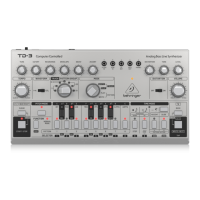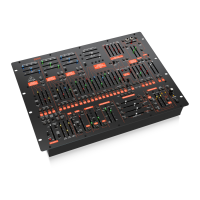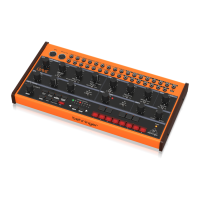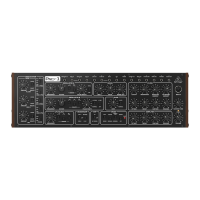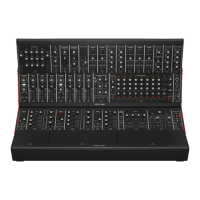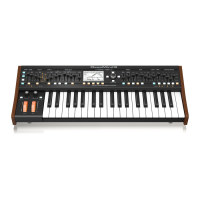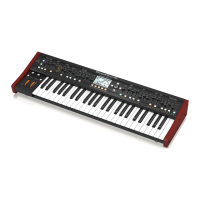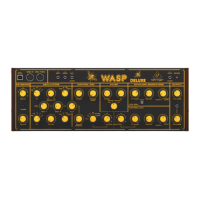23 NEUTRON User Manual
11. 5 Buzzing or humming sounds can be heard
from the audio outputs.
USB and or audio connections made between dierent devices using dierent
power supplies, sources or sockets can sometimes create ground loops. You can
attempt to resolve these grounding issues between computers and the Neutron
by following good grounding practice and ensuring all devices use the same
ground point. Unplugging one cable at time can make the background noises
better or worse, depending on how this aects the remaining ground loops.
By removing every audio cable and working through your studio item by item,
you can potentially eradicate ground-loop problems. Other possible solutions
include the use of a DI box to connect the Neutron to your audio mixer or sound
card where the transformer will isolate the audio connections.
11.6 There is no sound when using the external
audio input.
The Neutron needs the VCA envelope to be triggered and open. This can be
achieved via MIDI or an external E.GATE 1 input, adjust the ADSR settings in order
to hear the input signal.
Another way to use the external audio input is turning up the VCA BIAS in order
to hear audio.
12. Specications
Synthesizer Architecture
Number of oscillators 2 x V3340
Type Analog
Oscillators 2 (0.7 Hz to 55 kHz across 4 ranges)
LFO 1 (0.01 Hz to 10 kHz)
VCF
1 (switchable low pass, band pass or high pass
(12 dB/octave slope), dual output
Envelopes 2 analog envelope generators
Connectivity
External input ¼" TS unbalanced 100 k impedance
Output ¼" TRS, balanced, max. 12dBu
Headphones ¼" TRS, balanced
Headphones output
impedance
8
MIDI In/Out (soft Thru) 5-pin DIN/ 16 channels
USB (MIDI) USB 2.0, type B
USB
Type Class compliant USB 2.0, type B
Supported operating
systems
Windows 7 or higher/ Mac OS X 10.6.8 or higher
Oscillator Section
Controls
Tune (OSC 1&2): +1/-1 octave (8', 16' or 32') or +10/-10
(full range)
OSC mix: (linear blend control between OSC 1&2)
Shape (OSC 1&2): Tone Mod, Square, Sawtooth, Triangular
or Sine
Pulse width: 0 to 100% (OSC 1&2)
Switches
Range (OSC 1&2): 8', 16' or 32' or full range (all 3 LEDs)
OSC sync: on/o
Paraphonic: on/o
LED
Octave (OSC 1&2) 8', 16' or 32' or +/-10 (all 3 LEDs)
Shape (OSC 1&2): Tone Mod, Square, Sawtooth, Triangular
or Sine
Envelope 1
Controls
Attack: 300 µs to 5 s (linear attack)
Decay: 2.4 ms to 10 s (exponential decay)
Sustain: 0 V to 9 V
Release: 1.5 ms to 6 s (exponential release)
Envelope 2
Controls
Attack: 300 µs to 5 s (linear attack)
Decay: 2.4 ms to 10 s (exponential decay)
Sustain: 0 V to 9 V
Release: 1.5 ms to 6 s (exponential release)
Output Section
Controls Volume: 0 to 100%
LED MIDI: Gate signal
Sample & Hold Section
Controls
Rate: 0.26 Hz to 28 Hz (can be clocked from extrenal
source)
Glide: 500 µs to 1 s
LED Rate: 0.26 Hz to 28 Hz (can be clocked from extrenal
source)
Slew Rate Limiter Section
Controls
Slew rate: 1 ms to 3 s
Portamento time: 0 to 10 s
Attenuator Section
Controls
Attenuator 1: +4 dB to -∞
Attenuator 2: 0 dB to -∞
Filter Section
Controls
Cuto frequency: 10 Hz to 15 kHz
Resonance: 0 to 10 (capable of self oscillation)
Modualtion depth: 0 to 100%
Envelope depth: 0 to 100%
Noise: 0 to 100%
VCA bias: 0 to 100%
Switches
Filter mode, high pass, band pass and low pass
Filter key track: on/o
LED Filter mode, high pass, band pass and low pass
LFO Section
Controls
Shape: Sine, Triangle, Sawtooth, Square and Ramp
Rate: 0 to 10 (0.01Hz to 10kHz)
Switches Key sync: on/o
LED
Rate/Level indicator
Shape: Sine, Triangle, Sawtooth, Square and Ramp.
Delay Section
Controls
Time: 25 ms to 640 ms
Repeats: 0 to 100%
Mix: 0 to 100%
Overdrive Section
Controls
Drive: 0 to 11
Tone: 0 to 10
Level: 0 dB to -∞
LED Drive amount indicator

